Evaluating Health Policies: Medicaid, Medicare Advantage, and the ACA
VerifiedAdded on 2022/08/09
|8
|1897
|25
Report
AI Summary
This report provides an in-depth analysis of public health policies in the United States, with a specific focus on Medicaid and Medicare. The paper begins with an abstract outlining the need for structured health policies and then delves into the significance of health policy, discussing its goals and the key stakeholders involved. It outlines the types of health policies, with a detailed explanation of Medicare and Medicaid, including their benefits and target populations. The report examines the current policy landscape, highlighting the benefits of Medicaid and its public perception. It also discusses related issues and consequences of the policy, including challenges such as controlling costs and ensuring proper care. The report then introduces Medicare Advantage Plans as an alternative policy, comparing the pros and cons of both Medicaid and Medicare Advantage. Ultimately, the report recommends Medicare as a more beneficial option, offering a personalized plan structure and affordability, supported by an argumentative layout. The report references various sources to support its analysis and conclusions.
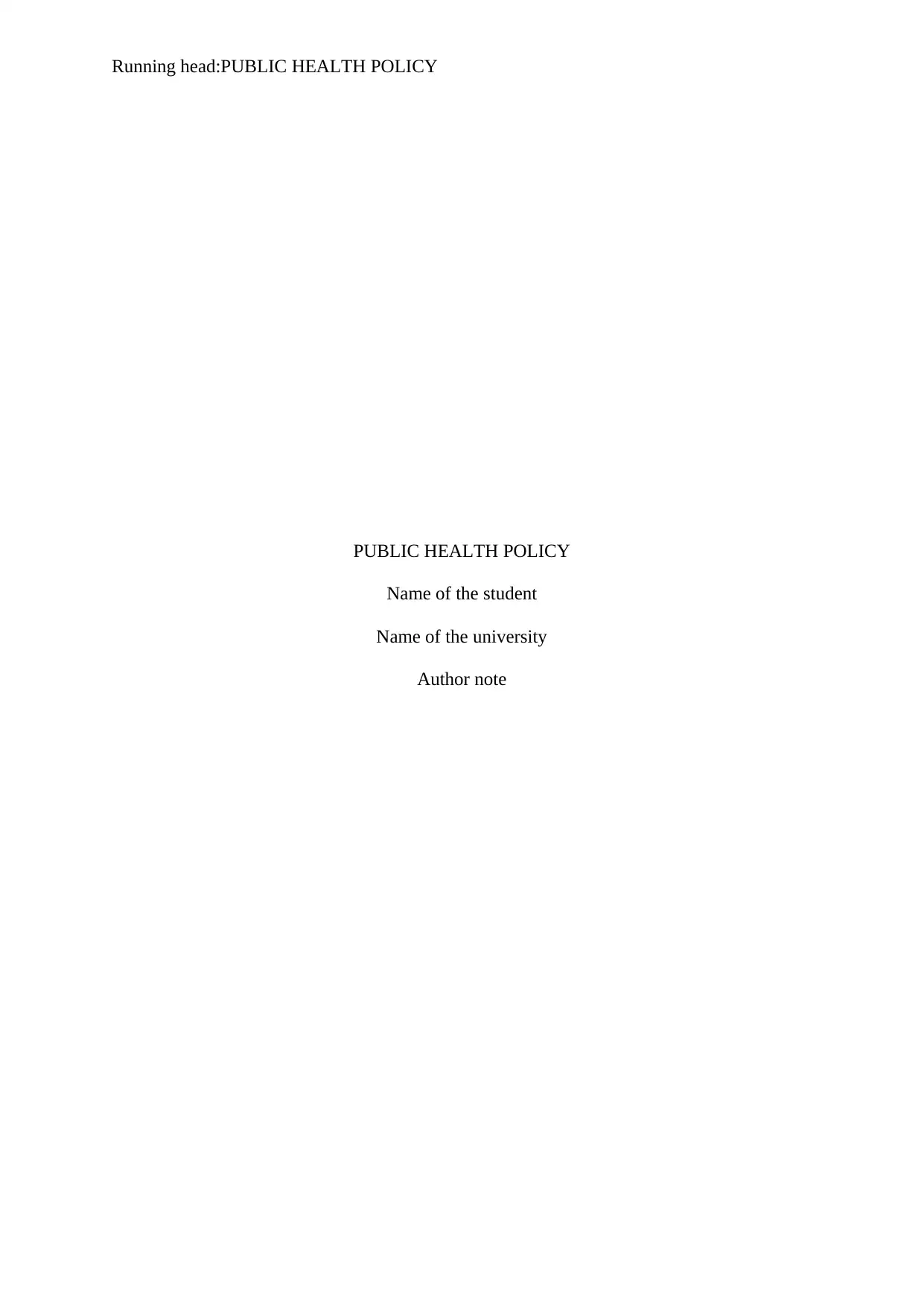
Running head:PUBLIC HEALTH POLICY
PUBLIC HEALTH POLICY
Name of the student
Name of the university
Author note
PUBLIC HEALTH POLICY
Name of the student
Name of the university
Author note
Paraphrase This Document
Need a fresh take? Get an instant paraphrase of this document with our AI Paraphraser
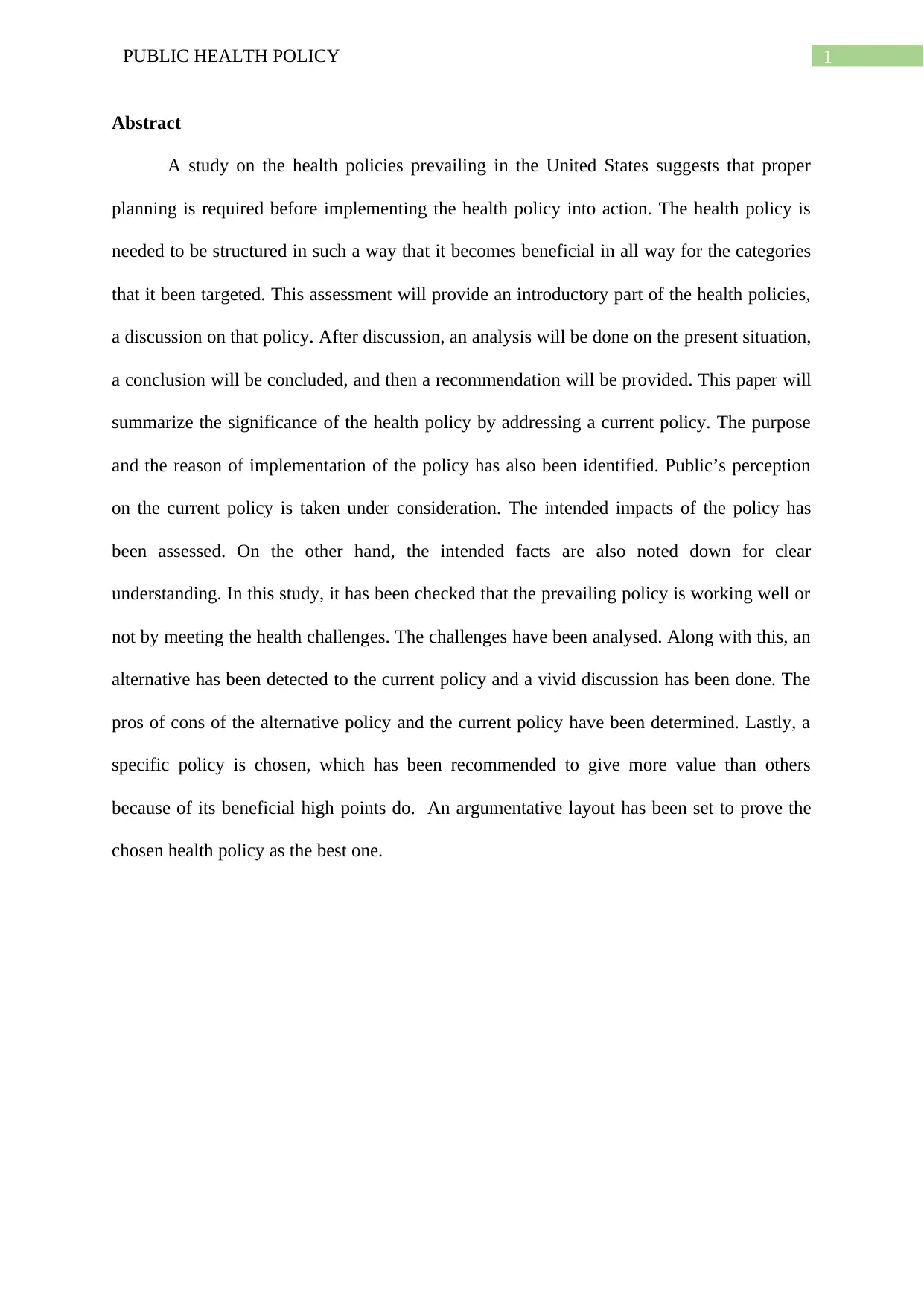
1PUBLIC HEALTH POLICY
Abstract
A study on the health policies prevailing in the United States suggests that proper
planning is required before implementing the health policy into action. The health policy is
needed to be structured in such a way that it becomes beneficial in all way for the categories
that it been targeted. This assessment will provide an introductory part of the health policies,
a discussion on that policy. After discussion, an analysis will be done on the present situation,
a conclusion will be concluded, and then a recommendation will be provided. This paper will
summarize the significance of the health policy by addressing a current policy. The purpose
and the reason of implementation of the policy has also been identified. Public’s perception
on the current policy is taken under consideration. The intended impacts of the policy has
been assessed. On the other hand, the intended facts are also noted down for clear
understanding. In this study, it has been checked that the prevailing policy is working well or
not by meeting the health challenges. The challenges have been analysed. Along with this, an
alternative has been detected to the current policy and a vivid discussion has been done. The
pros of cons of the alternative policy and the current policy have been determined. Lastly, a
specific policy is chosen, which has been recommended to give more value than others
because of its beneficial high points do. An argumentative layout has been set to prove the
chosen health policy as the best one.
Abstract
A study on the health policies prevailing in the United States suggests that proper
planning is required before implementing the health policy into action. The health policy is
needed to be structured in such a way that it becomes beneficial in all way for the categories
that it been targeted. This assessment will provide an introductory part of the health policies,
a discussion on that policy. After discussion, an analysis will be done on the present situation,
a conclusion will be concluded, and then a recommendation will be provided. This paper will
summarize the significance of the health policy by addressing a current policy. The purpose
and the reason of implementation of the policy has also been identified. Public’s perception
on the current policy is taken under consideration. The intended impacts of the policy has
been assessed. On the other hand, the intended facts are also noted down for clear
understanding. In this study, it has been checked that the prevailing policy is working well or
not by meeting the health challenges. The challenges have been analysed. Along with this, an
alternative has been detected to the current policy and a vivid discussion has been done. The
pros of cons of the alternative policy and the current policy have been determined. Lastly, a
specific policy is chosen, which has been recommended to give more value than others
because of its beneficial high points do. An argumentative layout has been set to prove the
chosen health policy as the best one.
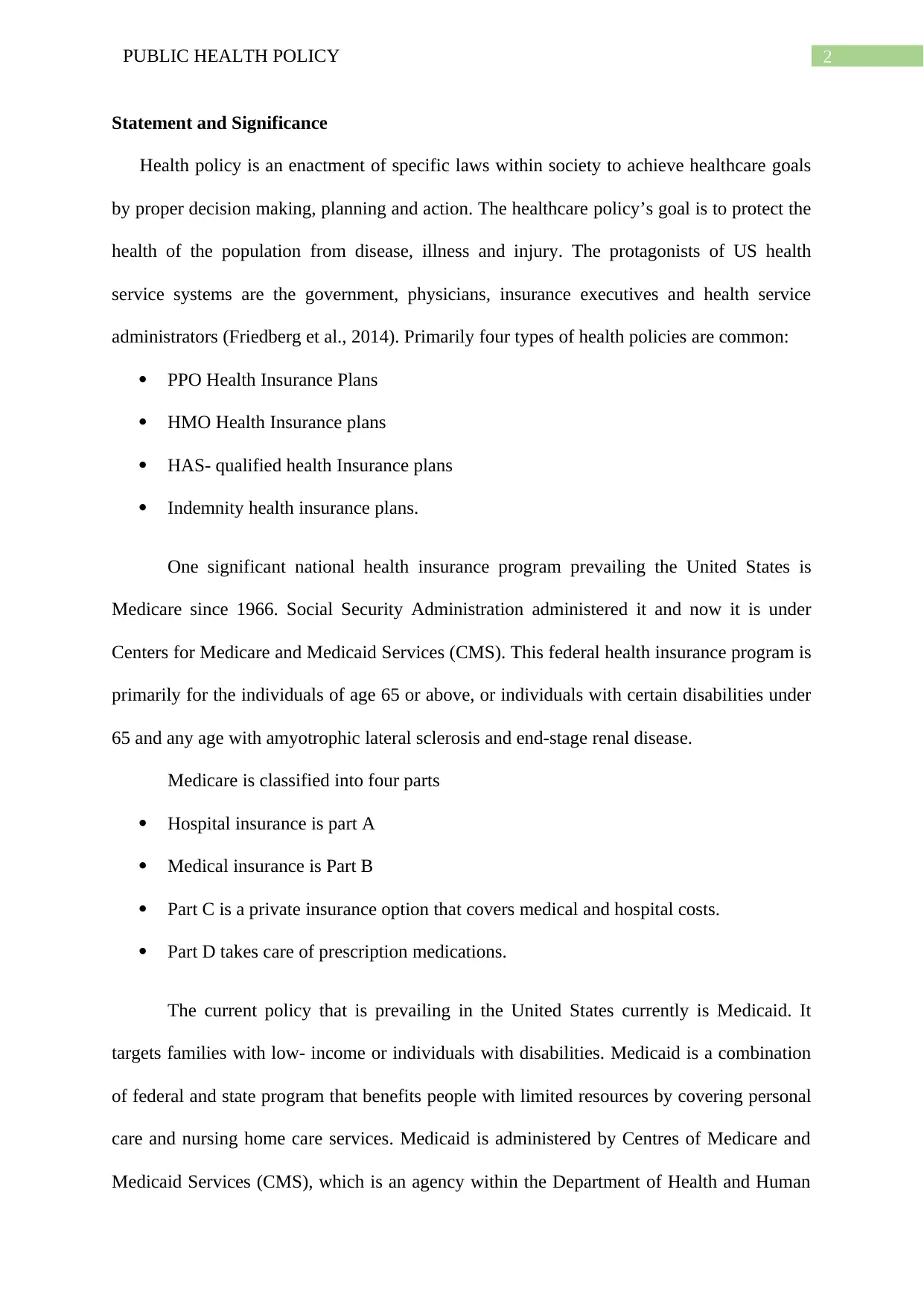
2PUBLIC HEALTH POLICY
Statement and Significance
Health policy is an enactment of specific laws within society to achieve healthcare goals
by proper decision making, planning and action. The healthcare policy’s goal is to protect the
health of the population from disease, illness and injury. The protagonists of US health
service systems are the government, physicians, insurance executives and health service
administrators (Friedberg et al., 2014). Primarily four types of health policies are common:
PPO Health Insurance Plans
HMO Health Insurance plans
HAS- qualified health Insurance plans
Indemnity health insurance plans.
One significant national health insurance program prevailing the United States is
Medicare since 1966. Social Security Administration administered it and now it is under
Centers for Medicare and Medicaid Services (CMS). This federal health insurance program is
primarily for the individuals of age 65 or above, or individuals with certain disabilities under
65 and any age with amyotrophic lateral sclerosis and end-stage renal disease.
Medicare is classified into four parts
Hospital insurance is part A
Medical insurance is Part B
Part C is a private insurance option that covers medical and hospital costs.
Part D takes care of prescription medications.
The current policy that is prevailing in the United States currently is Medicaid. It
targets families with low- income or individuals with disabilities. Medicaid is a combination
of federal and state program that benefits people with limited resources by covering personal
care and nursing home care services. Medicaid is administered by Centres of Medicare and
Medicaid Services (CMS), which is an agency within the Department of Health and Human
Statement and Significance
Health policy is an enactment of specific laws within society to achieve healthcare goals
by proper decision making, planning and action. The healthcare policy’s goal is to protect the
health of the population from disease, illness and injury. The protagonists of US health
service systems are the government, physicians, insurance executives and health service
administrators (Friedberg et al., 2014). Primarily four types of health policies are common:
PPO Health Insurance Plans
HMO Health Insurance plans
HAS- qualified health Insurance plans
Indemnity health insurance plans.
One significant national health insurance program prevailing the United States is
Medicare since 1966. Social Security Administration administered it and now it is under
Centers for Medicare and Medicaid Services (CMS). This federal health insurance program is
primarily for the individuals of age 65 or above, or individuals with certain disabilities under
65 and any age with amyotrophic lateral sclerosis and end-stage renal disease.
Medicare is classified into four parts
Hospital insurance is part A
Medical insurance is Part B
Part C is a private insurance option that covers medical and hospital costs.
Part D takes care of prescription medications.
The current policy that is prevailing in the United States currently is Medicaid. It
targets families with low- income or individuals with disabilities. Medicaid is a combination
of federal and state program that benefits people with limited resources by covering personal
care and nursing home care services. Medicaid is administered by Centres of Medicare and
Medicaid Services (CMS), which is an agency within the Department of Health and Human
⊘ This is a preview!⊘
Do you want full access?
Subscribe today to unlock all pages.

Trusted by 1+ million students worldwide
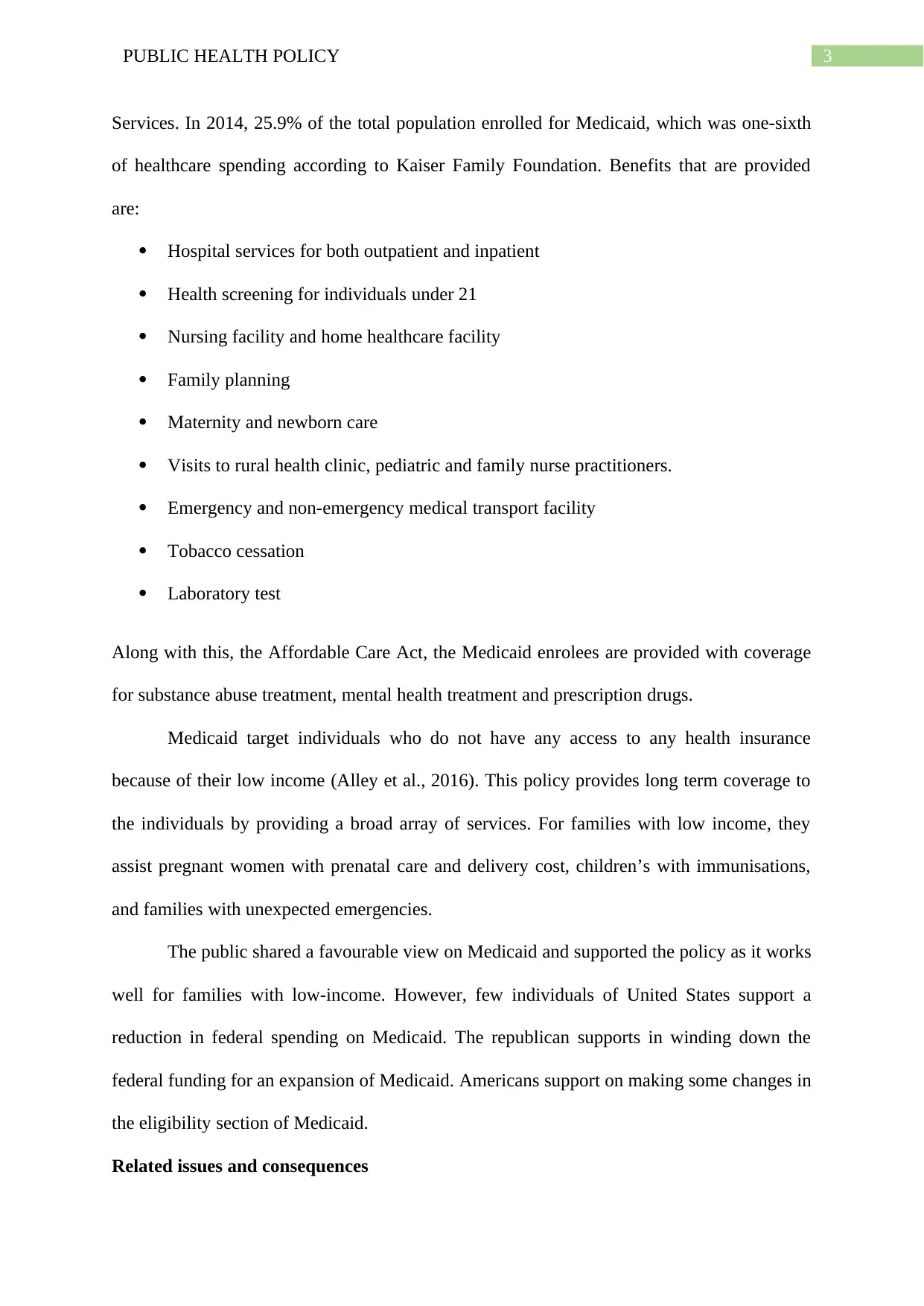
3PUBLIC HEALTH POLICY
Services. In 2014, 25.9% of the total population enrolled for Medicaid, which was one-sixth
of healthcare spending according to Kaiser Family Foundation. Benefits that are provided
are:
Hospital services for both outpatient and inpatient
Health screening for individuals under 21
Nursing facility and home healthcare facility
Family planning
Maternity and newborn care
Visits to rural health clinic, pediatric and family nurse practitioners.
Emergency and non-emergency medical transport facility
Tobacco cessation
Laboratory test
Along with this, the Affordable Care Act, the Medicaid enrolees are provided with coverage
for substance abuse treatment, mental health treatment and prescription drugs.
Medicaid target individuals who do not have any access to any health insurance
because of their low income (Alley et al., 2016). This policy provides long term coverage to
the individuals by providing a broad array of services. For families with low income, they
assist pregnant women with prenatal care and delivery cost, children’s with immunisations,
and families with unexpected emergencies.
The public shared a favourable view on Medicaid and supported the policy as it works
well for families with low-income. However, few individuals of United States support a
reduction in federal spending on Medicaid. The republican supports in winding down the
federal funding for an expansion of Medicaid. Americans support on making some changes in
the eligibility section of Medicaid.
Related issues and consequences
Services. In 2014, 25.9% of the total population enrolled for Medicaid, which was one-sixth
of healthcare spending according to Kaiser Family Foundation. Benefits that are provided
are:
Hospital services for both outpatient and inpatient
Health screening for individuals under 21
Nursing facility and home healthcare facility
Family planning
Maternity and newborn care
Visits to rural health clinic, pediatric and family nurse practitioners.
Emergency and non-emergency medical transport facility
Tobacco cessation
Laboratory test
Along with this, the Affordable Care Act, the Medicaid enrolees are provided with coverage
for substance abuse treatment, mental health treatment and prescription drugs.
Medicaid target individuals who do not have any access to any health insurance
because of their low income (Alley et al., 2016). This policy provides long term coverage to
the individuals by providing a broad array of services. For families with low income, they
assist pregnant women with prenatal care and delivery cost, children’s with immunisations,
and families with unexpected emergencies.
The public shared a favourable view on Medicaid and supported the policy as it works
well for families with low-income. However, few individuals of United States support a
reduction in federal spending on Medicaid. The republican supports in winding down the
federal funding for an expansion of Medicaid. Americans support on making some changes in
the eligibility section of Medicaid.
Related issues and consequences
Paraphrase This Document
Need a fresh take? Get an instant paraphrase of this document with our AI Paraphraser
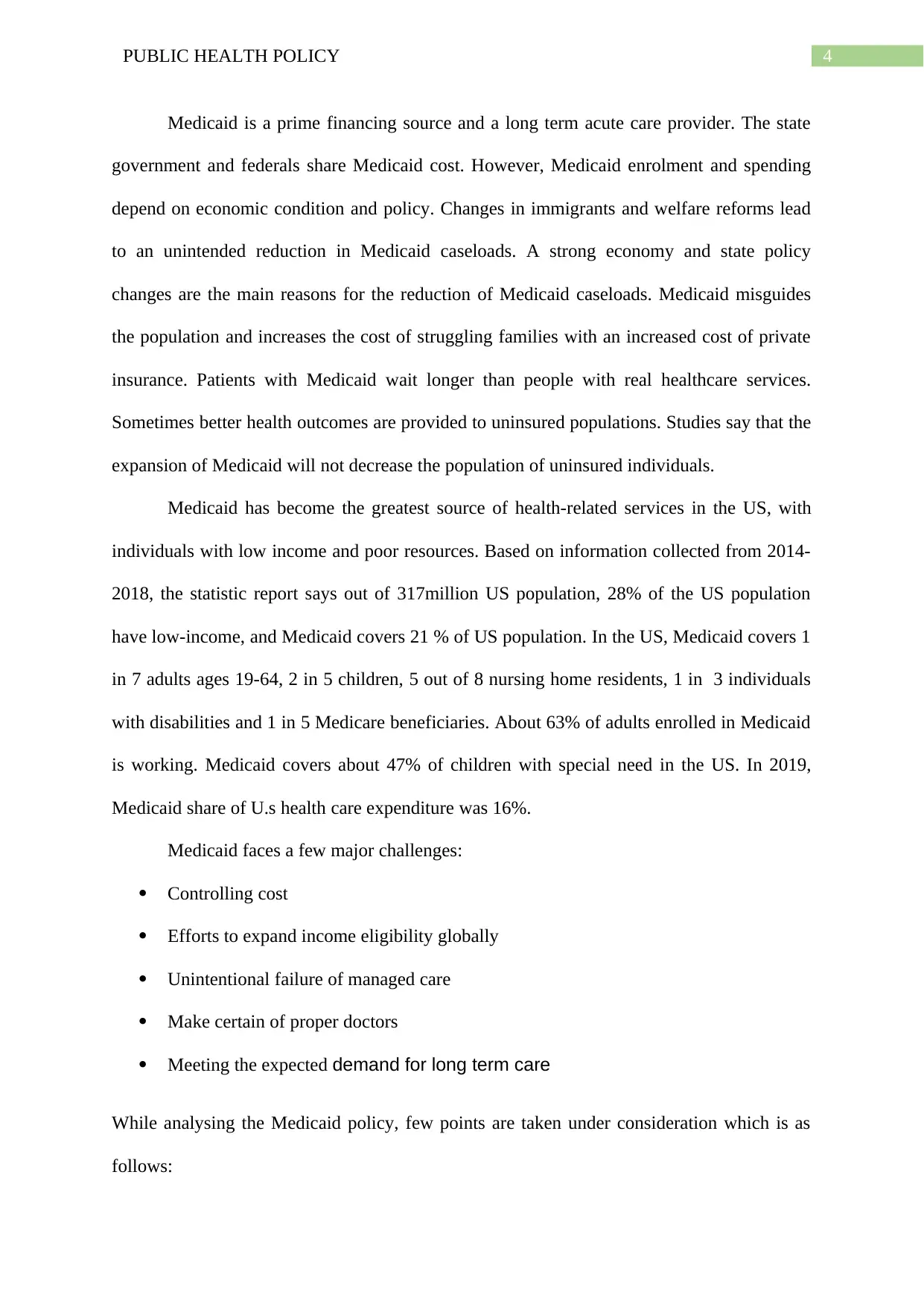
4PUBLIC HEALTH POLICY
Medicaid is a prime financing source and a long term acute care provider. The state
government and federals share Medicaid cost. However, Medicaid enrolment and spending
depend on economic condition and policy. Changes in immigrants and welfare reforms lead
to an unintended reduction in Medicaid caseloads. A strong economy and state policy
changes are the main reasons for the reduction of Medicaid caseloads. Medicaid misguides
the population and increases the cost of struggling families with an increased cost of private
insurance. Patients with Medicaid wait longer than people with real healthcare services.
Sometimes better health outcomes are provided to uninsured populations. Studies say that the
expansion of Medicaid will not decrease the population of uninsured individuals.
Medicaid has become the greatest source of health-related services in the US, with
individuals with low income and poor resources. Based on information collected from 2014-
2018, the statistic report says out of 317million US population, 28% of the US population
have low-income, and Medicaid covers 21 % of US population. In the US, Medicaid covers 1
in 7 adults ages 19-64, 2 in 5 children, 5 out of 8 nursing home residents, 1 in 3 individuals
with disabilities and 1 in 5 Medicare beneficiaries. About 63% of adults enrolled in Medicaid
is working. Medicaid covers about 47% of children with special need in the US. In 2019,
Medicaid share of U.s health care expenditure was 16%.
Medicaid faces a few major challenges:
Controlling cost
Efforts to expand income eligibility globally
Unintentional failure of managed care
Make certain of proper doctors
Meeting the expected demand for long term care
While analysing the Medicaid policy, few points are taken under consideration which is as
follows:
Medicaid is a prime financing source and a long term acute care provider. The state
government and federals share Medicaid cost. However, Medicaid enrolment and spending
depend on economic condition and policy. Changes in immigrants and welfare reforms lead
to an unintended reduction in Medicaid caseloads. A strong economy and state policy
changes are the main reasons for the reduction of Medicaid caseloads. Medicaid misguides
the population and increases the cost of struggling families with an increased cost of private
insurance. Patients with Medicaid wait longer than people with real healthcare services.
Sometimes better health outcomes are provided to uninsured populations. Studies say that the
expansion of Medicaid will not decrease the population of uninsured individuals.
Medicaid has become the greatest source of health-related services in the US, with
individuals with low income and poor resources. Based on information collected from 2014-
2018, the statistic report says out of 317million US population, 28% of the US population
have low-income, and Medicaid covers 21 % of US population. In the US, Medicaid covers 1
in 7 adults ages 19-64, 2 in 5 children, 5 out of 8 nursing home residents, 1 in 3 individuals
with disabilities and 1 in 5 Medicare beneficiaries. About 63% of adults enrolled in Medicaid
is working. Medicaid covers about 47% of children with special need in the US. In 2019,
Medicaid share of U.s health care expenditure was 16%.
Medicaid faces a few major challenges:
Controlling cost
Efforts to expand income eligibility globally
Unintentional failure of managed care
Make certain of proper doctors
Meeting the expected demand for long term care
While analysing the Medicaid policy, few points are taken under consideration which is as
follows:
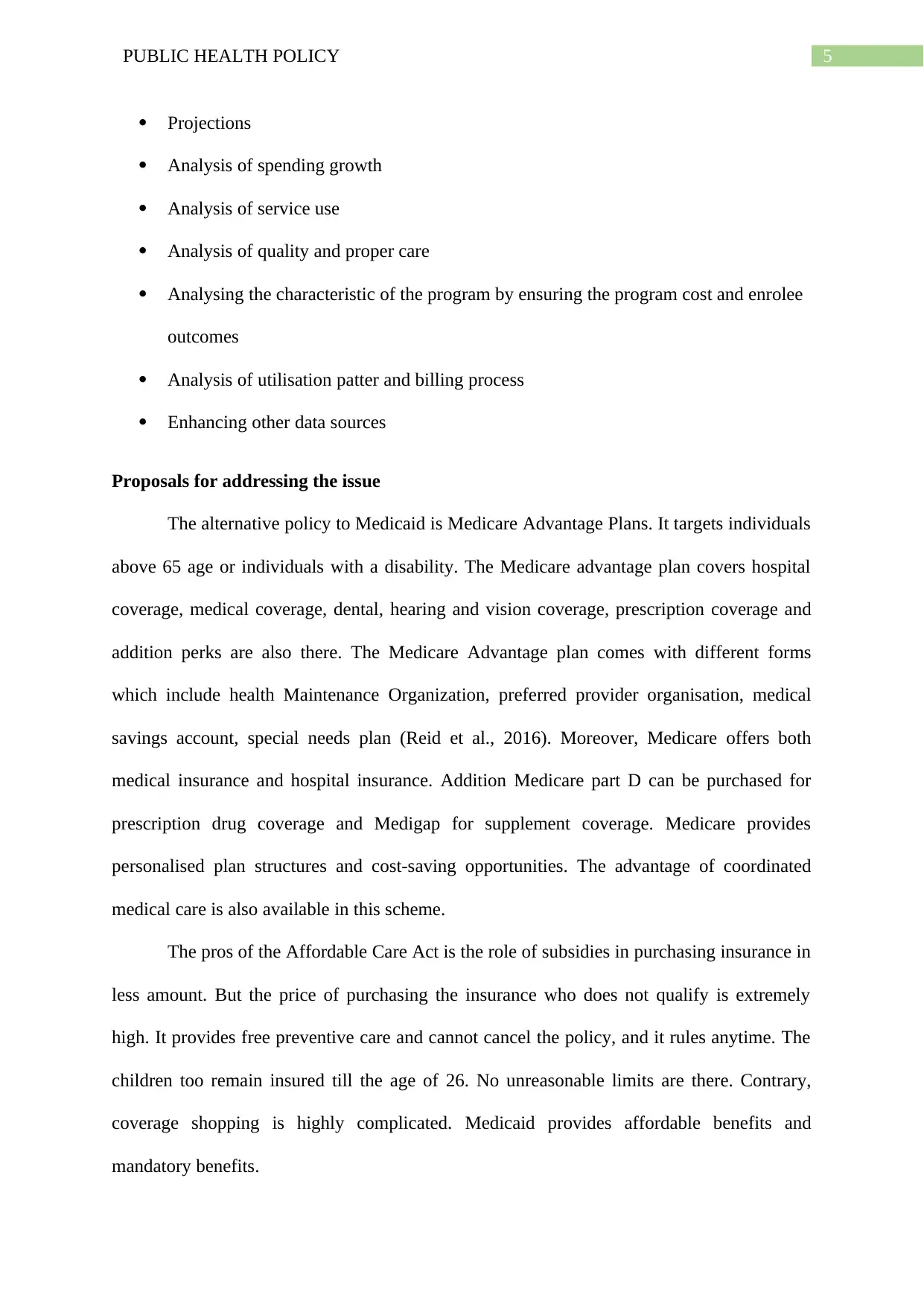
5PUBLIC HEALTH POLICY
Projections
Analysis of spending growth
Analysis of service use
Analysis of quality and proper care
Analysing the characteristic of the program by ensuring the program cost and enrolee
outcomes
Analysis of utilisation patter and billing process
Enhancing other data sources
Proposals for addressing the issue
The alternative policy to Medicaid is Medicare Advantage Plans. It targets individuals
above 65 age or individuals with a disability. The Medicare advantage plan covers hospital
coverage, medical coverage, dental, hearing and vision coverage, prescription coverage and
addition perks are also there. The Medicare Advantage plan comes with different forms
which include health Maintenance Organization, preferred provider organisation, medical
savings account, special needs plan (Reid et al., 2016). Moreover, Medicare offers both
medical insurance and hospital insurance. Addition Medicare part D can be purchased for
prescription drug coverage and Medigap for supplement coverage. Medicare provides
personalised plan structures and cost-saving opportunities. The advantage of coordinated
medical care is also available in this scheme.
The pros of the Affordable Care Act is the role of subsidies in purchasing insurance in
less amount. But the price of purchasing the insurance who does not qualify is extremely
high. It provides free preventive care and cannot cancel the policy, and it rules anytime. The
children too remain insured till the age of 26. No unreasonable limits are there. Contrary,
coverage shopping is highly complicated. Medicaid provides affordable benefits and
mandatory benefits.
Projections
Analysis of spending growth
Analysis of service use
Analysis of quality and proper care
Analysing the characteristic of the program by ensuring the program cost and enrolee
outcomes
Analysis of utilisation patter and billing process
Enhancing other data sources
Proposals for addressing the issue
The alternative policy to Medicaid is Medicare Advantage Plans. It targets individuals
above 65 age or individuals with a disability. The Medicare advantage plan covers hospital
coverage, medical coverage, dental, hearing and vision coverage, prescription coverage and
addition perks are also there. The Medicare Advantage plan comes with different forms
which include health Maintenance Organization, preferred provider organisation, medical
savings account, special needs plan (Reid et al., 2016). Moreover, Medicare offers both
medical insurance and hospital insurance. Addition Medicare part D can be purchased for
prescription drug coverage and Medigap for supplement coverage. Medicare provides
personalised plan structures and cost-saving opportunities. The advantage of coordinated
medical care is also available in this scheme.
The pros of the Affordable Care Act is the role of subsidies in purchasing insurance in
less amount. But the price of purchasing the insurance who does not qualify is extremely
high. It provides free preventive care and cannot cancel the policy, and it rules anytime. The
children too remain insured till the age of 26. No unreasonable limits are there. Contrary,
coverage shopping is highly complicated. Medicaid provides affordable benefits and
mandatory benefits.
⊘ This is a preview!⊘
Do you want full access?
Subscribe today to unlock all pages.

Trusted by 1+ million students worldwide
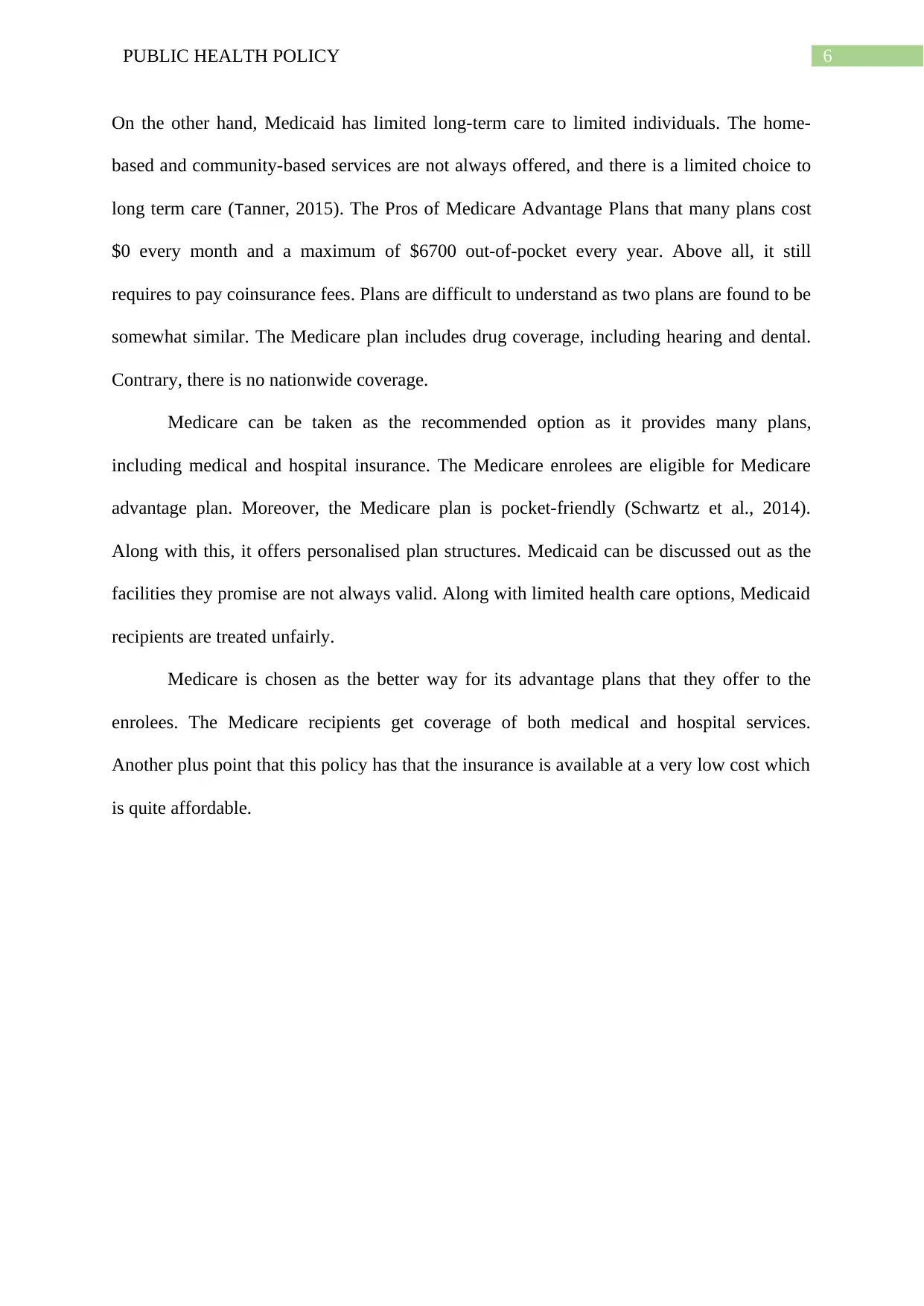
6PUBLIC HEALTH POLICY
On the other hand, Medicaid has limited long-term care to limited individuals. The home-
based and community-based services are not always offered, and there is a limited choice to
long term care (Tanner, 2015). The Pros of Medicare Advantage Plans that many plans cost
$0 every month and a maximum of $6700 out-of-pocket every year. Above all, it still
requires to pay coinsurance fees. Plans are difficult to understand as two plans are found to be
somewhat similar. The Medicare plan includes drug coverage, including hearing and dental.
Contrary, there is no nationwide coverage.
Medicare can be taken as the recommended option as it provides many plans,
including medical and hospital insurance. The Medicare enrolees are eligible for Medicare
advantage plan. Moreover, the Medicare plan is pocket-friendly (Schwartz et al., 2014).
Along with this, it offers personalised plan structures. Medicaid can be discussed out as the
facilities they promise are not always valid. Along with limited health care options, Medicaid
recipients are treated unfairly.
Medicare is chosen as the better way for its advantage plans that they offer to the
enrolees. The Medicare recipients get coverage of both medical and hospital services.
Another plus point that this policy has that the insurance is available at a very low cost which
is quite affordable.
On the other hand, Medicaid has limited long-term care to limited individuals. The home-
based and community-based services are not always offered, and there is a limited choice to
long term care (Tanner, 2015). The Pros of Medicare Advantage Plans that many plans cost
$0 every month and a maximum of $6700 out-of-pocket every year. Above all, it still
requires to pay coinsurance fees. Plans are difficult to understand as two plans are found to be
somewhat similar. The Medicare plan includes drug coverage, including hearing and dental.
Contrary, there is no nationwide coverage.
Medicare can be taken as the recommended option as it provides many plans,
including medical and hospital insurance. The Medicare enrolees are eligible for Medicare
advantage plan. Moreover, the Medicare plan is pocket-friendly (Schwartz et al., 2014).
Along with this, it offers personalised plan structures. Medicaid can be discussed out as the
facilities they promise are not always valid. Along with limited health care options, Medicaid
recipients are treated unfairly.
Medicare is chosen as the better way for its advantage plans that they offer to the
enrolees. The Medicare recipients get coverage of both medical and hospital services.
Another plus point that this policy has that the insurance is available at a very low cost which
is quite affordable.
Paraphrase This Document
Need a fresh take? Get an instant paraphrase of this document with our AI Paraphraser
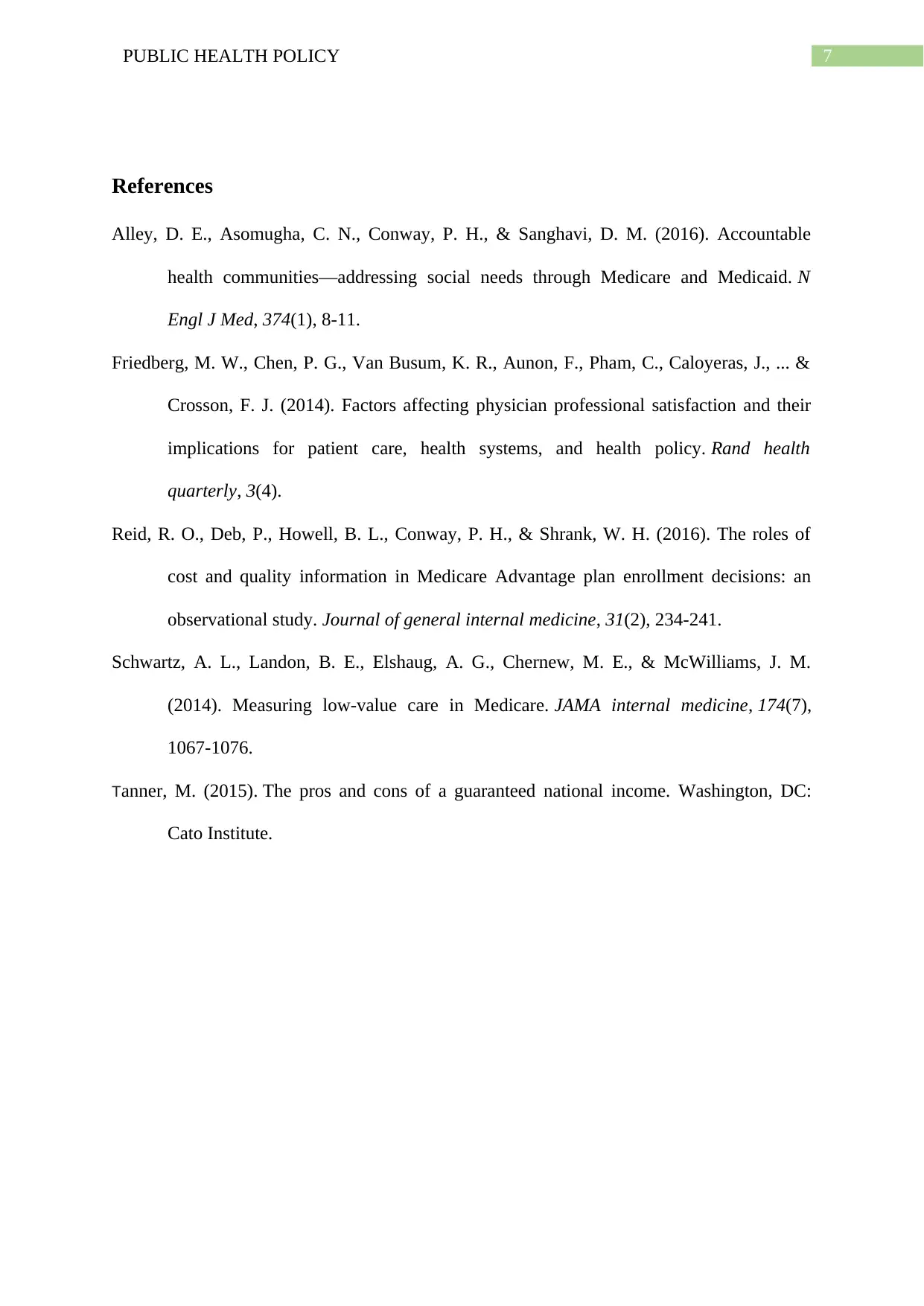
7PUBLIC HEALTH POLICY
References
Alley, D. E., Asomugha, C. N., Conway, P. H., & Sanghavi, D. M. (2016). Accountable
health communities—addressing social needs through Medicare and Medicaid. N
Engl J Med, 374(1), 8-11.
Friedberg, M. W., Chen, P. G., Van Busum, K. R., Aunon, F., Pham, C., Caloyeras, J., ... &
Crosson, F. J. (2014). Factors affecting physician professional satisfaction and their
implications for patient care, health systems, and health policy. Rand health
quarterly, 3(4).
Reid, R. O., Deb, P., Howell, B. L., Conway, P. H., & Shrank, W. H. (2016). The roles of
cost and quality information in Medicare Advantage plan enrollment decisions: an
observational study. Journal of general internal medicine, 31(2), 234-241.
Schwartz, A. L., Landon, B. E., Elshaug, A. G., Chernew, M. E., & McWilliams, J. M.
(2014). Measuring low-value care in Medicare. JAMA internal medicine, 174(7),
1067-1076.
Tanner, M. (2015). The pros and cons of a guaranteed national income. Washington, DC:
Cato Institute.
References
Alley, D. E., Asomugha, C. N., Conway, P. H., & Sanghavi, D. M. (2016). Accountable
health communities—addressing social needs through Medicare and Medicaid. N
Engl J Med, 374(1), 8-11.
Friedberg, M. W., Chen, P. G., Van Busum, K. R., Aunon, F., Pham, C., Caloyeras, J., ... &
Crosson, F. J. (2014). Factors affecting physician professional satisfaction and their
implications for patient care, health systems, and health policy. Rand health
quarterly, 3(4).
Reid, R. O., Deb, P., Howell, B. L., Conway, P. H., & Shrank, W. H. (2016). The roles of
cost and quality information in Medicare Advantage plan enrollment decisions: an
observational study. Journal of general internal medicine, 31(2), 234-241.
Schwartz, A. L., Landon, B. E., Elshaug, A. G., Chernew, M. E., & McWilliams, J. M.
(2014). Measuring low-value care in Medicare. JAMA internal medicine, 174(7),
1067-1076.
Tanner, M. (2015). The pros and cons of a guaranteed national income. Washington, DC:
Cato Institute.
1 out of 8
Related Documents
Your All-in-One AI-Powered Toolkit for Academic Success.
+13062052269
info@desklib.com
Available 24*7 on WhatsApp / Email
![[object Object]](/_next/static/media/star-bottom.7253800d.svg)
Unlock your academic potential
Copyright © 2020–2025 A2Z Services. All Rights Reserved. Developed and managed by ZUCOL.





